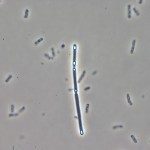Link to Pubmed [PMID] – 10941796
J. Mol. Microbiol. Biotechnol. 1999 Aug;1(1):141-8
Carbon catabolite repression of several catabolic operons in Bacillus subtilis is mediated by the repressor CcpA. An inactivation of the ccpA gene has two distinct phenotypes: (i) catabolite repression of catabolic operons is lost and (ii) the growth of bacteria on minimal medium is severely impaired. We have analyzed the physiological properties of a ccpA mutant strain and show that the ccpA mutation does not affect sugar transport. We have isolated extragenic suppressors of ccpA that suppress the growth defect (sgd mutants). Catabolite repression of beta-xylosidase synthesis was, however, not restored suggesting that the suppressor mutations allow differentiation between the phenotypes of the ccpA mutant. A close inspection of the growth requirements of the ccpA mutant revealed the inability of the mutant to utilize inorganic ammonium as a single source of nitrogen. An intact ccpA gene was found to be required for expression of the gltAB operon encoding glutamate synthase. This enzyme is necessary for the assimilation of ammonium. In a sgd mutant, gltAB operon expression was no longer dependent on ccpA, suggesting that the poor expression of the gltAB operon is involved in the growth defect of the ccpA mutant.

